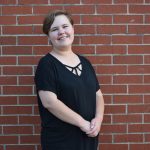The science department dealt with outdated equipment, carpeted labs and sweltering lecture rooms in Webster Hall. The program received major improvements when the Interdisiplinary Science Building was completed in 2017.
Webster graduate student Thomas Quintero joined the university during the centennial celebration of Webster Hall. This meant Quintero took his first science courses at the university in the hundred-year-old building. He remembers associating a “sense of tradition” with the old building, but adds any attachment was sentimental and not practical.
The Interdisciplinary Science Building (ISB) was founded in 2017. The new building offered students and faculty major improvements and opportunities in contrast to Webster Hall.
According to Stephanie Schroder, professor and chair of Biological Sciences at Webster University, around 10 to 15 students enrolled in biochemistry when she began teaching at Webster in 2003. That number, however, grew and reached over 30 students. “We just didn’t fit in the basement of Webster Hall anymore,” Schroder said.
Ryan Groeneman, a chemistry professor, knew the limitations of the Webster Hall labs firsthand. He said the single available chemistry lab housed classes almost constantly, making research difficult for students attempting to finish their senior thesis. “It was a nightmare to schedule it. My research students just had to sneak in when labs were running,” Groeneman said.
Quintero described the chemistry lab at Webster Hall as “the most disorganized room” he had ever seen. Now, Schroder said the new building offers students significantly more space for learning and independent research. When the science department made the move to the ISB, they were also able to provide new and improved equipment.
Schroeder, Groeneman, Quintero, and adjunct professor Lisa Grantham all agreed that the hoods in the ISB were a major improvement when compared to Webster Hall. The concerns over the health and safety risks involved in hyper-congested space were no longer an issue. Quintero said, “You could have access to a safe working environment at all times, so that’s huge.”

In terms of new equipment, the science department has received sinks in every lab, dishwashers, computer facilities in the ISB.
Another opportunity that came with the ISB was the creation of a chemistry major. Groeneman said that, before the ISB was built, the only chemistry courses available supported the biology curriculum. The one chemistry lab at Webster Hall was already in use for the majority of the day, so Groeneman said it would have been impossible to create the major while at Webster Hall and provide the appropriate facilities for students. The construction of the ISB offered the science department the room it needed to add the necessary classes.
Faculty were not the only people to take advantage of the new opportunities the ISB had to offer. Quintero co-founded a chapter of the Beta Beta Beta (TriBeta) National Honor Society during his senior year after the ISB was completed. This society is based on student’s understanding and exploration of biological sciences.
Quintero said that before the ISB was completed, he would not have tried to involve Webster in the TriBeta honor society. “The ISB kind of shows that the school is growing and that we are making an investment in science,” Quintero said.
Generally, Grantham said she thought the new building allowed students to have greater confidence in their work. “A state-of-the-art research facility… lets them feel like Webster does care about the science program,” Grantham said.
There is a general consensus that the ISB has contributed to a positive working atmosphere for the science department. “This building is an incredible addition to Webster,” Quintero said. “It helps make students more passionate about what we are doing because it really feels like what you are doing is actual real science.”
Share this post
Cas Waigand (she/her) was the editor-in-chief for the Journal (Spring 2021). She majored in journalism with a minor in photography. Cas also covered COVID-19 and the 2020 general election. She enjoys writing, watching Netflix, crocheting, and taking photos.




